“Why do we fall, Bruce?
So we can learn to pick ourselves up.” — Thomas Wayne
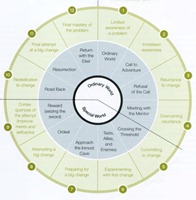
Courtesy Nancy Duarte (click to enlarge)
As I’ll be discussing in more detail in an upcoming post, The Dark Knight Rises is the final act in Chris Nolan’s epic and now-classic Batman trilogy. Nolan is a master-storyteller, so in The Dark Knight Rises, Bruce embarks (unwillingly) on a classic hero’s journey so that he can complete his quest, which is to save Gotham from its own evil.
Using the Hero’s Journey as a lens to watch the film shows us Nolan’s larger vision for what Batman means.
Our Hero, Bruce Wayne
Bruce’s original goal (in Batman Begins) was to become a symbol that could save Gotham. Bruce transformed a symbol of his own fear (of bats) into a symbol of hope for Gotham. But Batman wasn’t supposed to last forever; Bruce saw himself retiring the Batman and making a life with Rachel. As Bruce began to inspire people like Harvey, he saw his end as Batman nearing.
Ironically, we learn in The Dark Knight Rises that Bruce was right. He was almost done being Batman. But not like he expected: when the Joker killed Rachel and corrupted Harvey, Bruce lost hope.
What Bruce didn’t know (thanks to Alfred), was that Rachel had already given up on a life with him. Rachel saw some fatal flaw in Bruce. She didn’t believe that could change, that he could have a life without Batman.
Rachel didn’t believe that Bruce could ever escape from the pit of fear he’d fallen in as a boy.
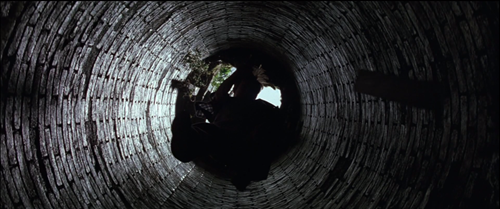 The Ordinary World: Gotham
The Ordinary World: Gotham
In the ordinary world, we meet the hero, encounter the problem and learn he’s insufficient for it.
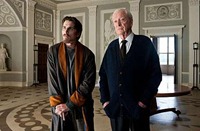 It’s eight years after The Dark Knight, and the city is virtually crime-free. Bruce has retired from being Batman, and now lives as a recluse in the rebuilt Wayne Manor. (1)
It’s eight years after The Dark Knight, and the city is virtually crime-free. Bruce has retired from being Batman, and now lives as a recluse in the rebuilt Wayne Manor. (1)
Rachel might have been right. Bruce is still stuck in despair and hopelessness. Not only is he not Batman anymore, but he can’t get past Rachel’s death. He’s become a total recluse, alone in his pain except for Alfred. Miranda Tate Talia recognizes that he’s stuck when she tells him
“You have a practiced apathy Mr. Wayne. But a man who doesn’t care doesn’t spend half his fortune on a plan to save the world. And isn’t so wounded when it fails that he goes into hiding.” — Miranda Tate
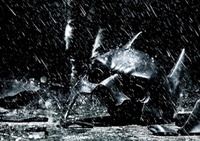
Is Talia only talking about their failed clean energy project? Or does she see what Bruce’s defeats at the hands of the Joker have done to him?
In the Ordinary World of Gotham, the Batman has cost Bruce everything. He’s totally alone, except for Alfred, who despairs of ever calling Bruce out of his isolation.
When Bane appears in Gotham, Bruce perceives this as his chance to recover what he’s lost. But he’s wrong.
Like Bruce, we expect the “Call to Adventure” (2) to be assuming the Batman mantle again. But it’s not. Ironically, Bruce’s Call is to find a life beyond Batman.
Alfred repeatedly pleas with Bruce to put away the Batman and move on with his life. To leave Gotham and find a life somewhere else.
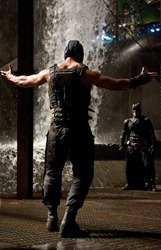
Bruce rejects Alfred’s invitation (3) to live beyond Batman, to escape the despair Gotham represents. Instead, he goes to confront Bane, who becomes his unlikely mentor. (4)
Bane leads the League of Shadows, so none of Batman’s theatrics or tricks phase him. Bruce Wayne is a child born in light who uses the darkness as a tool. But Bane is darkness. He describes himself as “evil” and “the devil” and claims to have been born in Hell on Earth. Bane mocks Bruce as he breaks him:
“The shadows have betrayed you. Because they belong to me… You think darkness is your ally. But you merely adopted it. I was born in it. Molded by it.” — Bane
Bruce can’t save us from Evil because he hasn’t conquered Evil.
Bane tells Bruce he can’t win because Bruce doesn’t comprehend true despair. Bruce thinks that he has been to Hell and back, but he has yet to face true evil. As Bruce’s surprising mentor, Bane offers to teach Bruce the true meaning of despair, leaving him broken and alone in the prison that is Hell on Earth, to watch as Bane systematically destroys the city Bruce fights to save.
 The Special World: Hell on Earth
The Special World: Hell on Earth
In the Special World, the hero meets allies and learns skills he will need to achieve his goal.
In the prison, Bruce only wants to die until he sees what Bane does to Gotham. When he sees his city in peril, Bruce commits to the impossible: he will escape from Hell. (5)
Bruce tries twice to climb from the pit, to no avail. (6) Despite his efforts to heal – which have returned him to arguably better shape than he’s been in for a decade, Bruce cannot escape. The two men charged by Bane to keep him alive urge him to quit trying, explaining to him that no one ever makes the final jump.
When Bruce claims he’s not afraid, the prison’s doctor asserts that is Bruce’s fatal flaw:
You don’t fear death you think this makes you strong it makes you weak… How can you foster the impossible without the most powerful impulse? — Prison Doctor

Bruce doesn’t love life. In the wake of Rachel’s death, Bruce hasn’t loved anything. He’s been waiting for death, eager to embrace it as a long-lost companion. This is why Bruce couldn’t save Rachel, couldn’t truly save Gotham. This is what Rachel knew when she decided to marry Harvey:
Bruce realizes that never truly climbed out of the pit he fell into as a boy.
From within that pit of fear and despair, Bruce used that fear and anger as weapons. Against petty evil like Organized Crime, his weapons worked. Against the chaotic force of the Joker, who understood how silly an angry little boy dressing up to scare people really is, Bruce’s weapons were much less effective.
And against the pit itself, against the incarnation of its Evil that Bane represents, Bruce failed utterly and was broken. How can darkness fight darkness?
To defeat Bane, Bruce needs more than Evil’s tools. He must embrace Hope and Life. (7)
Bruce makes his third climb without the safety rope, makes his jump knowing that if he falls this time, all is lost.
But Bruce doesn’t fall. He rises. Because now he fights for life. He’s finally climbed out of that pit. (8-9)
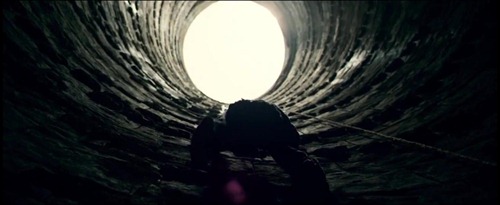 Return to the Ordinary World: Victory
Return to the Ordinary World: Victory
The hero returns to the ordinary world with his new tools or skills. They enable him to achieve his goal.
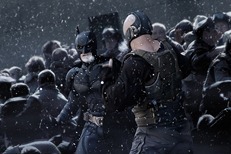
Bruce returns to Gotham a different person. As he gathers his allies, marshaling them for the final confrontation with Bane (10-11), he’s almost joyful.
When Bane sees the giant Bat burning, he utters a single word:
Impossible.
In the end, we learn that Bane never climbed out of that pit. Bane never conquered despair. For Bane, every day of his life is still in that pit, much like Bruce was before his ordeal. So Bane cannot defeat this new Batman who fights for life, for redemption.
Bane never conquered the Pit, so Bane cannot conquer one who has conquered. Bane knows only Despair, so he cannot conquer Hope.
Bruce stops Bane and is able to save Gotham. But more than that, he redeems the symbol of the Batman. Now Batman has become hope and salvation to Gotham, and the Batman lives on in the person of John Blake. Having faced Death, Bruce is able to leave and have a life with Selina. All that Bruce originally set out to do he has accomplished. (12)
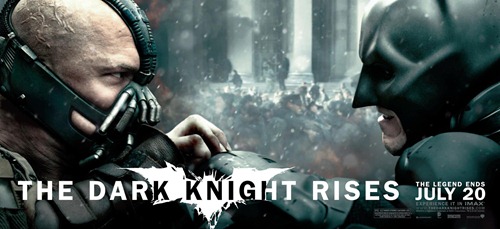 Bruce as Jesus: Resurrection
Bruce as Jesus: Resurrection
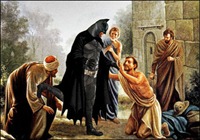
Bruce Wayne’s Hero’s Journey mirrors the most famous and important Hero’s Journey of them all: Jesus of Nazareth.
The Dark Knight Rises presents Bruce as an obvious Christ-character. Bruce cannot defeat the forces of evil using the weapons of Evil, anymore than Jesus could defeat the power of Sin and Death by raising armies and conquering. Rather, Bruce had to die, to descend into Hell and rise again before he could truly rescue Gotham from Evil. Similarly, Jesus’ death on the Cross defeated Death itself, and his resurrection welcomes humanity into a new reality free of evil and death.
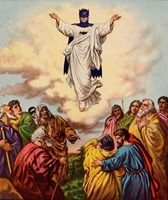
Bane could not understand how Bruce came back. He could not imagine a world in which Bruce’s hero’s journey was possible. As such, he could not overcome Batman and the Gotham he raised around him to fight back. Similarly, the forces of evil in our world cannot understand the power of God’s Love, the power believers enact when we choose to forgive those who wrong us, to love our enemies and give ourselves up for the good of someone else.
Bruce’s Hero’s Journey enabled him to become a symbol of hope that called the people of Gotham to be better than they had been. We see how Bruce’s return affects several characters sliding into despair – Commissioner Gordon, Foley, Blake and notably Selina Kyle (the subject of my next post). Each of these characters is inspired to choose hope, to stay in Gotham, to fight rather than hide. Similarly, Jesus’ life and death teach those who follow him how to overcome the Death we encounter in our daily lives.
